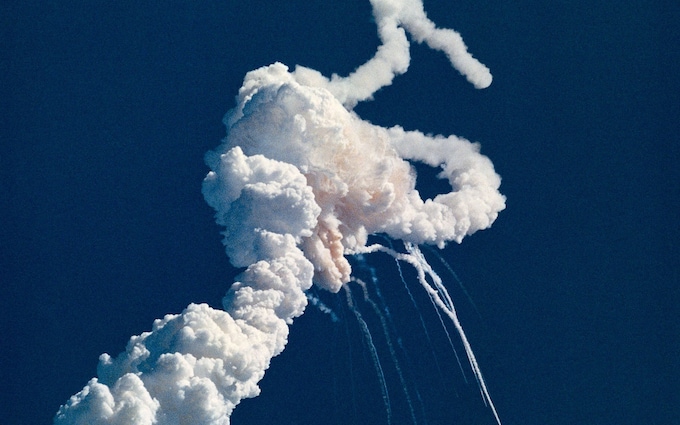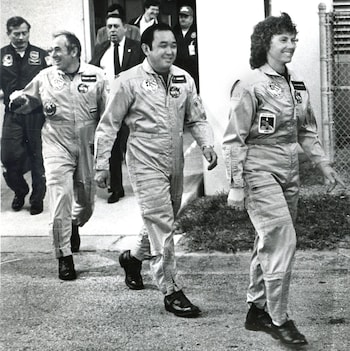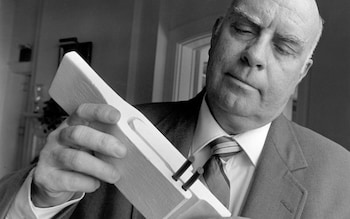
‘There was the world before the Challenger accident and the world after’
Adam Higginbotham, the author of the first full account of the Space Shuttle disaster, on what went wrong – and who, if anyone, was to blame

Corporate groupthink, top management believing their own hype, an unwavering belief in technological infallibility, and the marginalisation of whistleblowers. No, not the Post Office in 2018, but Nasa in 1986, when the Challenger Space Shuttle exploded 73 seconds after launch and killed all seven astronauts on board. It’s a story told for the first time in full by Adam Higginbotham, whose Challenger: A True Story of Heroism and Disaster on the Edge of Space is devastating and riveting in equal measures.
Challenger was in its own way an American bereavement every bit as seismic as 9/11 and the assassination of JFK. “It was a shattering of confidence in technology and the optimism which went with that,” says Higginbotham, a British writer who now lives in New York and has been US correspondent for The Sunday Telegraph and editor-in-chief of The Face. “Nasa had established a reputation of regularly achieving the impossible. Even their disasters like Apollo 13 were perceived as successful failures, guys brought back from the brink.”
The shuttle programme was launched in April 1981, less than three months after Ronald Reagan had taken office as President, and was an important part of his “Morning in America” vision: that Watergate, Vietnam and the Iran hostage crisis had been consigned to history, and America was back where it belonged as the shining city on a hill, as Abraham Lincoln’s “last best hope of earth”.

“In the years before 1986, pictures and video of the shuttle were everywhere in popular culture,” Higginbotham tells me. “And then that was replaced with the image of Challenger’s destruction.” That image sears the soul no matter how many times you watch it: this glorious testament to the might of human daring and ingenuity trailing flame like a comet’s tail as it soars towards space, and then a ball of fire and two arms of smoke reaching out in opposite directions, the thunderous rocket roar suddenly silent, contrails curling and falling like spent fireworks. Then comes launch commentator Steve Nesbitt’s eventual, stunned: “Flight controllers here looking very carefully at the situation. Obviously a major malfunction.”
“For a few seconds afterwards,” Higginbotham says, “people found it almost impossible to conceive that the shuttle had actually been destroyed right in front of them. Nothing like that had ever happened before.” The similarities with the first plane smashing into the North Tower on 9/11, the way in which onlookers’ brains refused to process what their eyes had seen, is clear. “There was a world before the Challenger accident and the world after the Challenger accident in the same way that there was a pre-9/11 world and post-9/11 world.”
Higginbotham’s book is, surprisingly, the first attempt to tell the whole story of Challenger and its context in more than 35 years. His first book was Midnight in Chernobyl: The Untold Story of the World’s Greatest Nuclear Disaster, and “people often asked me whether I remembered where I was when I heard about Chernobyl. I didn’t, but I did remember very clearly where I was when I heard about Challenger almost exactly three months before. I completed my school day [in Somerset] and went out with my friends. So I didn’t learn about it until later that night when I got home. My mother told me, and I just couldn’t comprehend what she was saying.

“So when I started looking for a subject for my second book, Challenger was already on my mind. Since 1987, when a couple of books were written by journalists there at the time, nobody had really attempted a serious narrative nonfiction account of everything that happened: there have only been individual memoirs and technical or academic takes. But a lot of people who hadn’t been willing or able to talk about it back then were now prepared to do so: and these people are beginning to pass away, so I wanted to tell the story before those memories slipped away with them.”
Higginbotham would go on to interview more than 60 people between September 2020 and October 2023, including members of the astronauts’ families ,“who were extremely receptive”, and Nasa officials “who could not have been more helpful”.
The mission designated STS-51-L was the 25th time the Space Shuttle had gone up, and was watched live by schoolchildren across the nation because a teacher was going into space for the first time. Christa McAuliffe of Concord, New Hampshire, had beaten more than 11,000 applicants for the role, and in the year before the launch she was among the most famous women in America.

The Teacher in Space initiative had been designed to increase public interest in the space shuttle. After the ambition and scope of the lunar missions, a low orbit shuttle programme looked like small beer. “It was as if the 16th-century explorer Ferdinand Magellan had proposed to follow up the first circumnavigation of the world by rowing across Lisbon harbour and back,” Higginbotham writes. But in engineering terms, the shuttles were much more complex than the Apollo modules that had taken 12 men to the moon between 1969 and 1972. The shuttles (there would eventually be five fully operational ones) had to be rocket, spacecraft and airplane all in one, and they needed to be reusable too.
It’s here that both the parallels with Chernobyl – “the other side of the mirror” – and the heart of the story can be found: the intersection of technology and humanity, collective and individual, risk and expediency, management and engineering, budgets and demands. Behind the ostensibly simple cause of the disaster, “the failure of a single Viton pressure seal in the aft field joint of the spacecraft’s right-hand solid rocket booster”, are layers upon layers of story, pressures within and without.
Nasa needed regular flights to maintain public interest and congressional funding, and Challenger was the second launch in a row to have been delayed by bad weather and technical glitches. Morton Thiokol, the company which built the rocket boosters, had a billion-dollar contract riding on their continued ability to deliver. And everyone was working with less money than they wanted and needed. “The Rogers Commission Report [into the disaster] traces the limitations of the design of the shuttle back to its budget constraints,” says Higginbotham. “That’s the original sin of the shuttle.”

The sociologist Diane Vaughan referred to “the normalisation of deviance”. As Higginbotham puts it: “You start off with a closely defined set of safety characteristics and gradually, almost unconsciously, expand what the parameters of safety are, until you end up with a situation further down the line where an outsider coming in would say ‘that’s extraordinarily dangerous.’ But where Vaughan concluded that it was that no-one’s fault, everybody did their part and followed the rules, with the blame being laid at the feet of the organisation as a whole, this dehumanised machine in which each cog bears no responsibility,” Higginbotham is more measured.
He doesn’t accept Vaughan’s total exculpation of individuals, but nor does he portray any of those individuals as moustache-twirling villains. “It’s easy to get the impression that people like Larry Mulloy [manager of the solid rocket booster programme] were wilfully sending seven people to their death. They were arrogant, and some of the things they said certainly came off as deeply callous. But they weren’t knowingly gambling with people’s lives. They really believed they’d made the correct engineering analysis, that they’d arrived at a reasonable assessment of what they regarded as an acceptable risk. They believed they were right. And they were just wrong. The part of the system most likely to give way is the people.”
And Challenger is above all a story of people: those who flew, those who built, those who warned, those who ignored, those who watched, those left behind. Although McAuliffe got the lion’s share of attention at the time, Higginbotham gives equal weight to all seven astronauts, among them Judith Resnik, the first Jewish woman in space, and the first Asian-American, Ellison Onizuka. And though there may be no outright villains, there is a hero: the Morton Thiokol engineer Roger Boisjoly.

Boisjoly had warned that the O-ring seals, 12-foot rubber gaskets on the rocket boosters, were liable to fail in the unseasonably cold conditions at launch: it was Florida’s coldest winter in almost a century. Gasket failure would mean the escape of burning fuel and the possibility of a catastrophic explosion: on one previous mission, a gasket had been less than half a second from disaster. Each O-ring was deemed a Criticality-1 item, where failure would mean the loss of vehicle, mission and crew.
Boisjoly’s sense of responsibility was very personal. Twelve years before the Challenger disaster, while employed at Rockwell, he had witnessed a colleague effectively having a nervous breakdown at his desk. That colleague had helped design the cargo doors on the McDonnell Douglas DC-10, and had tried without success to change the design for fear that the doors could inadvertently open in flight.
In March 1974, this exact eventuality had occurred on Turkish Airlines 981 outside Paris, killing all 346 people on board. It remains the deadliest single aircraft accident without survivors. “That day,” Higginbotham says, “Boisjoly decided that he would never be the person put in that position by his managers. And it was that which years later made him so determined that the Challenger launch would not go ahead.”

But Boisjoly’s warnings went unheeded: a fix would take too much time and cost too much money. After he testified at the Rogers Commission and refused to toe the company line, he was shunned by colleagues and managers, and moved away from space work. “His life was destroyed by this,” Higginbotham says. “Neighbours ostracised him in church and hounded his wife. He found a dead rabbit left in his mailbox. Twice, while taking walks out of town beside the highway, passing drivers tried to run him off the road with their cars.”
He suffered depression and received but a single public gesture of support from the space community. Sally Ride, the first American woman in space, hugged him after his commission appearance. “She was the only one,” he said. “The only one.” Boisjoly died in 2012, aged 73.
Almost four decades on from the Challenger disaster, some lessons have clearly been learnt. Nasa’s contracts with SpaceX and Boeing codify that the chance of overall mission loss can be no greater than 1 in 270; SpaceX puts the faces of astronauts on work orders to remind the engineers that lives depend on them. But each mission is also to some extent a roll of the dice: space travel was, is, and always will be dangerous. As Bill Lucas, director of Nasa’s Marshall Space Center at the time of Challenger, said: “In the high-risk business that Nasa is in, the only way that you can preclude a flight problem is not fly.”
Challenger is published by Viking at £25. To order your copy for £19.99, call 0808 196 6794 or visit Telegraph Books